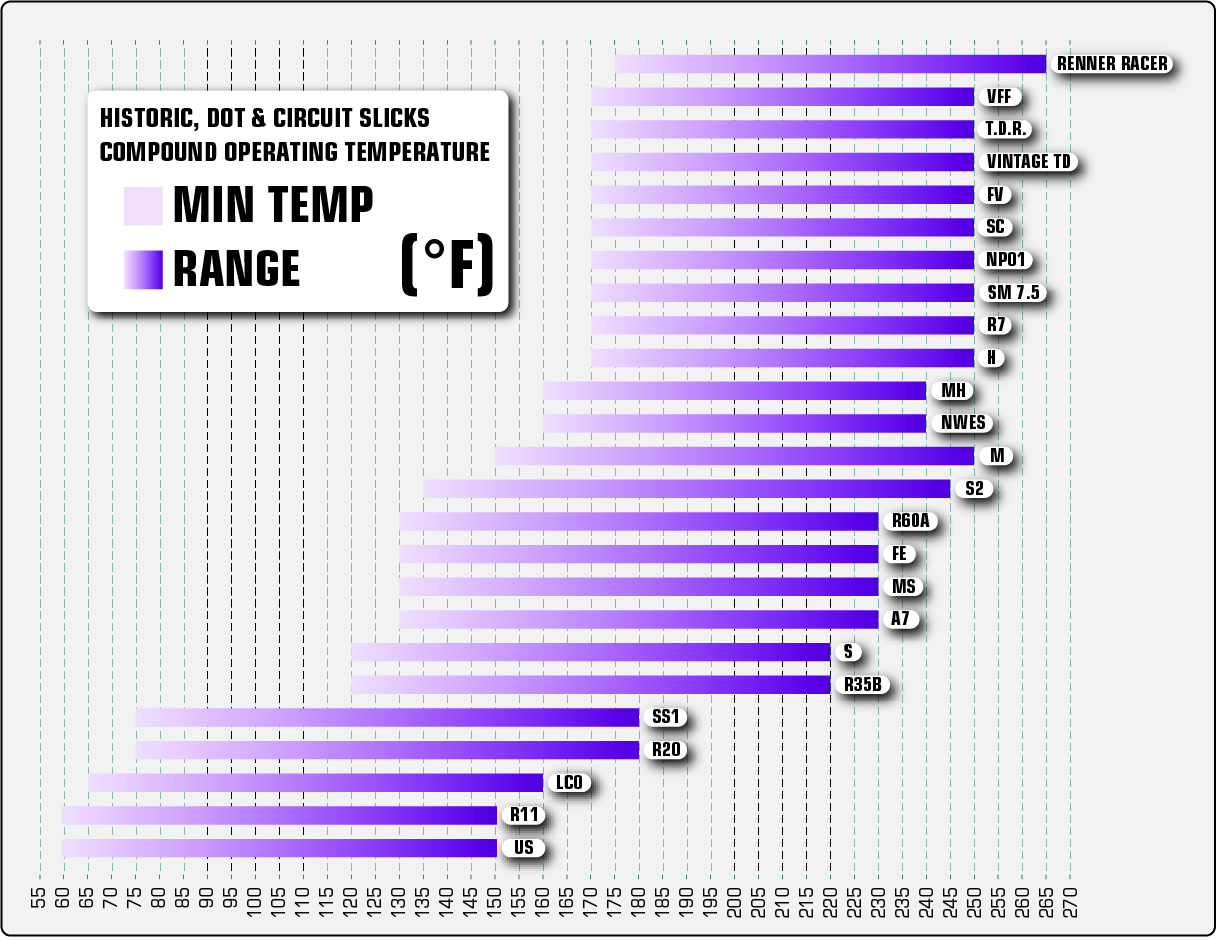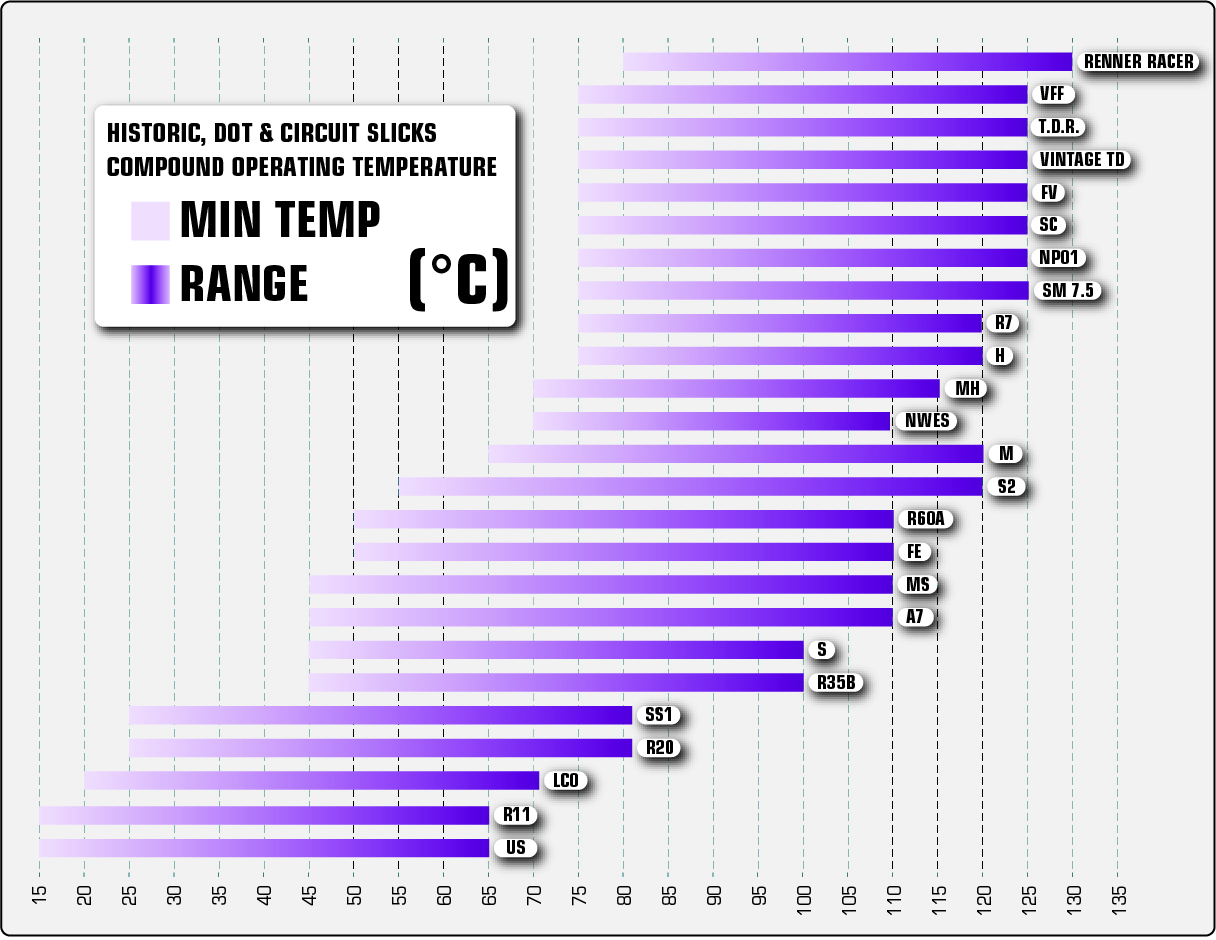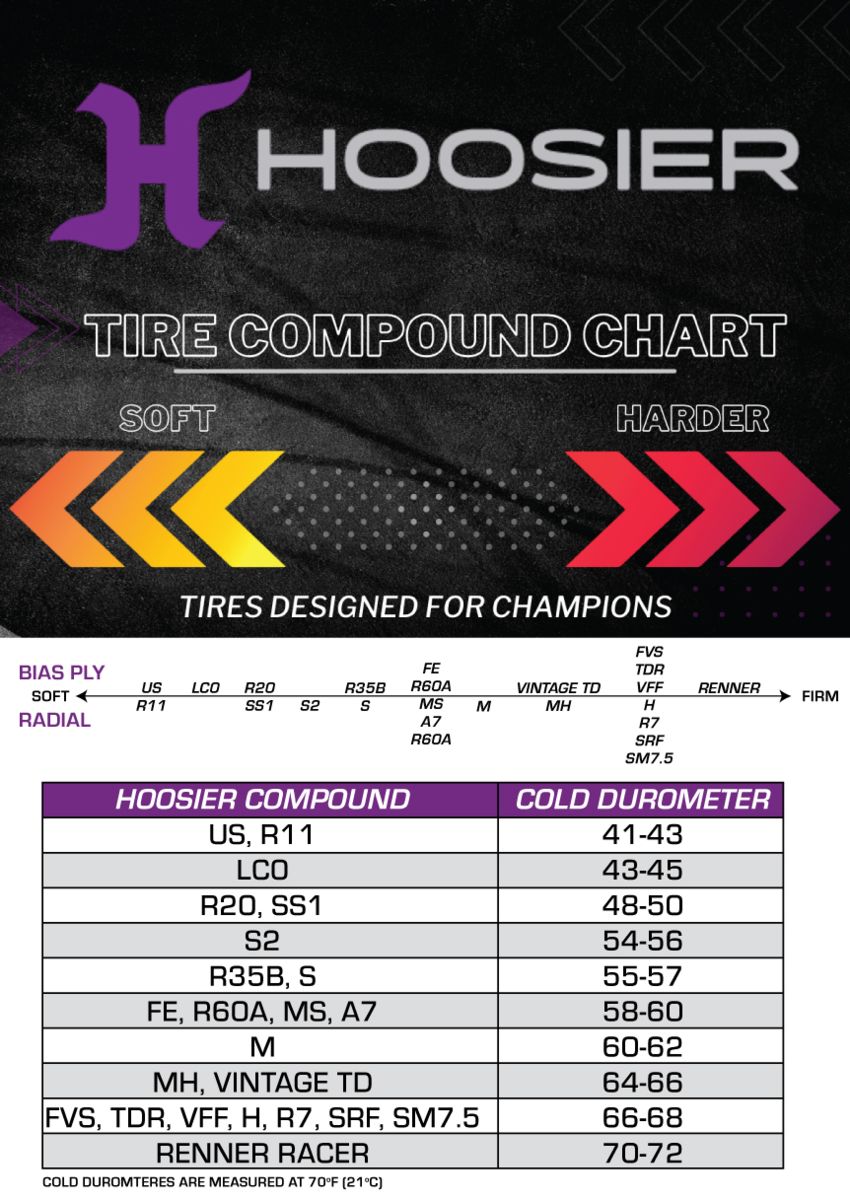
Hoosier Racing Tire has been producing circuit racing tires since 1984
During that time, Hoosier has become the largest supplier of domestic circuit racing tires.
Hoosier Tire has been the winning point of contact on every active permanent circuit in the U.S.
With the ongoing success, our legacy continues to expand reaching into more and more points in the global racing tire markets.
High Bank Oval Recommendations
Safety Warnings
A7/R7 Safety Tips
RCES Setup Guidelines
QUESTIONS:
1. What is the number written on my bias race tire in yellow chalk?
2. How do I get Hoosier Tire decals for my race car?
3. What rim width should I use for my application?
4. Does it matter which direction I mount my tires?
5. How do I know when it is time to replace my R7/A7 competition radials?
6. What are the do's and don'ts when storing Hoosier race tires at the end of the racing season??
7. Compound Charts
1. What is the number written on my bias race tire in yellow chalk?
As a result of a tire being bias in design (as opposed to radial), it will have a circumference that varies from tire to tire. This is not something that is unique to Hoosier but is common to all bias tire manufacturers. However, Hoosier has went to the expense of placing a "chalk-mark" on its bias ply tires in an attempt to assist the consumer in making the proper selection when purchasing new tires. It is something Hoosier does that our competition does not. Now, to understand its use, you need to understand a little of the manufacturing process as well.
After a tire is cured, it is removed from the press and placed on a machine called a "post-inflator". On this machine each tire has air injected into it for a set period of time. The amount of air is determined by our engineering department and is not the same for every type of tire Hoosier produces. After a set time period, a tire is then measured and the circumference is recorded. Then a press operator writes the size on the side of treaded tires and on the tread of slicks, in yellow chalk. All Hoosier bias ply tires with a chalk-mark, follow this same process.
Now, how should the chalk mark be interpreted? It should be viewed as a reference point or a guide on purchasing tires by size to attempt to attain a certain stagger. Say for instance, you needed to replace your right front tire. Your car currently has 1" of stagger (with the RF @ 28 p.s.i.) but you want to get 1 1/2" of stagger. The tire you were replacing had an original chalk mark of 86", and had a roll out, of say, 85". Obviously, you would want to purchase a tire bigger than the 86" tire you removed. Most likely, a tire with a chalk-mark of 86 1/2". You have to remember there are many factors that go into what size a tire will actually measure. The ambient temperature that day, the air pressure in the tire, whether the tire is new or old. These are factors that no, one person, controls. You just need to be aware of their existence and work with what you know. The chalk mark does not tell you the circumference of the tire at running pressure, it does not tell you how big a tire will grow to, it tells you that a tire is either going to be bigger or smaller than another one with a different chalk mark. It's just that simple. Bias ply tires, by nature, are going to vary in size, whether you buy a Hoosier or the competition's tire. By keeping good records, using common sense and understanding how the chalk-mark Hoosier tires provide, you will be step ahead in selecting the proper sized tire(s).
2. How do I get Hoosier Tire decals for my race car? Request decals by emailing info@hoosiertire.com including your mailing address, division of racing and whether you want black, white or purple decals.
3. What rim width should I use for my application?
The answer depends on which type of tire you are using. For our radial tires a good rule of thumb is to take the tread width dimension (+-) 1/2 inch. This will put you in the optimum range for the tire. The tire will mount on a wheel outside of this range, however performance and wear may be negatively affected.
If you find that your vehicle, or the rules, will not allow a wide enough wheel for the tire you think you would like, consider using a narrower tire. In most cases a properly sized wheel/tire combination will outperform a wider tire on a wheel that is too narrow.
If you are looking at our DOT bias racing tires the tolerance is a bit broader. For our DOT bias line we publish a "measured rim" or "design rim" dimension. This dimension simply indicates the width of the wheel the tire was mounted on when the other listed dimensions are recorded.
Bias ply tires are more tolerant of a range of wheel sizes. Typically, the listed rim dimension is a good starting point. The wider tires can range (+-) an inch without noticeable change in performance. A narrow (less than 6" wide) tire will tolerate (+-) 1/2 inch.
This would also apply to the Historic product line in our tire specs.
In the Road Racing section of our product line the racing slicks are typically designed for specific applications where the wheel width is controlled. The tire is designed to perform at its best on the wheel listed in the "design rim" or "recommended rim" column. Once again, there is a tolerance for this dimension. The tire will mount on a different sized rim but, may exhibit unusual wear or stability outside of the recommended rim.
This is particularly important on "cantilevered" tires. This is a specific type of construction used in racing classes which have very narrow wheel restrictions. The design of the tire allows the usable tread to far exceed the width of the wheel. These tires should ONLY be mounted on the rim sizes indicated in the specs.
Why are the listed rim dimensions different than the recommendations?
Whenever a D.O.T. tire spec is published there are Tire & Rim Association guidelines for the specific rim size for a particular tire. This is intended to standardize the information so that it is possible to compare one brand of tire to another.
For performance uses these Tire & Rim Association recommendations may not reflect a best choice or the designed application.
4. Does it matter which direction I mount my tires?
All Hoosier tires having directional arrows must be mounted so that the tire travels in the direction of the arrow. Hoosier tires having directional arrows will have them on both sidewalls. Directional arrows may not be on a tire that can have both a left and/or right side application. All Hoosier tires not having directional arrows should be mounted as detailed below.
Every Hoosier race tire has a four character serial code embossed into one sidewall of the tire. All Hoosier DOT tires will also have two additional codes as required by the Department of Transportation. (Example: J7AB 4AX8 3701)
5. How do I know when it is time to replace my R7/A7 competition radials?
Located on the tread surface of the tires are small divots or holes. These divots are called tread depth holes and are used to measure the wear of tread. Tread depth is usually referred to in 32nds of an inch. A brand new tire should measure 4/32 of depth in each of the holes. By keeping track of the number of laps on each set of tires and measuring the depth of tread, you can calculate how much wear is left in the tires. When the holes are completely flush with the tread, it is definitely time to change to a new set of tires. There is tread rubber under the depth hole and the tire can continue to be run, but the driver must be aware the performance level will be at its lowest. When this rubber below the depth hole is gone, you will then see the first layer of cords. At this point, the safety of the tire is now compromised and the worn tires should be replaced.
The driver must be the ultimate measure of when to replace the tires. There might be measurable tread depth on the tire, but the performance (grip or handling) of the tire might be low. To get the most wear out of your R7/A7 competition tires, be sure to rotate front to rear or side to side after an event.
Get Tire Care Tips for A7/R7.
6. What are the do's and don'ts when storing Hoosier race tires at the end of the racing season? Tire Storage
The useful life of a tire, whether mounted or dismounted, is directly affected by storage conditions. Tires should always be stored indoors in a dark, cool, dry room.
DO
1 Remove the tires from the vehicle.
2. Remove the air from the tires and store them on their side in a cool/dark/dry environment.
3. Place tires in a black plastic bag when stored during the "off-season".
4. Make sure the temperature range in the storage location is between 40-90 degrees Fahrenheit.
DON'T
1. Don't store tires in direct sunlight or near electric motors. (Electric motors emit small amounts of ozone.) Tires need to be protected from light, especially sunlight. Light causes ultraviolet damage by breaking down the rubber compounds. The storeroom should not contain electrical welding or any other equipment that could produce ozone.
2. Don't apply any chemical treatments to Hoosier tires. (It's not necessary and may actually damage the integrity of the tire by breaking down the rubber properties of the tire.) Tires must not be allowed to come in contact with oils, greases, solvents, or other petroleum products that cause rubber to soften or deteriorate.
3. Don't store tires in sub-freezing temperatures for any length of time. (The rubber can freeze and may crack as a result.)
7. Compound Charts






.png)

Have an FSAE question? Contact Jeff Speer
2025 FSAE Ordering Information // Spring Rate Data // FSAE TTC - Force & Moment Data

SLICKS
|
|---|
WETS
|
|---|
All pricing in United States Dollars (USD) effective January 1, 2025. Pricing Listed for Domestic FSAE Teams Only. See your local Hoosier Tire distributor for pricing outside the USA

| Catalog # | Size Designation | Wheel Size | Circ. | O/A Dia. | Tread Width | Section Width | Tire Weight | |
|---|---|---|---|---|---|---|---|---|
| SLICKS | ||||||||
| 43570 | 240/580R15 | 15 x 10 | 72.1" | 22.9" | 9.4" | 10.6" | 16.3 lbs. | |
| 43578 | 330/620R15 | 15 x 14 | 76.8" | 24.4" | 13.3" | 15.1" | 21.3 lbs. | |
| WETS | ||||||||
| 44511 | 23.0x9.0R15 | 15 x 10 | 72.3" | 23.0" | 9.4" | 10.7" | 16 lbs. | |
| 44516 | 24.5x13.0R15 | 15 x 14 | 76.6" | 24.4" | 13" | 15.1" | 21.6 lbs. |
Spring Rate Data
For more information please contact Jeff Speer.

| Catalog # | Size Designation | Wheel Size | Circ. | O/A Dia. | Tread Width | Section Width | Tire Weight | |
|---|---|---|---|---|---|---|---|---|
| SLICKS | ||||||||
| 43164 | 20.5x7.0-13 R60A | 13 x 6 | 66.2" | 21.0" | 6.75" | 8.0" | 12 lbs. | |
| 43285 | 22.0x8.0-13 R60A | 13 x 8 | 69.0" | 22.0" | 8.0" | 9.6" | 14 lbs. | |
| WETS | ||||||||
| 44185 | 21.0x6.5-13 W3 | 13 x 6 | 66.5" | 21.2" | 6.7" | 7.2" | 11 lbs. | |
| 44196 | 22.0x8.0-13 W3 | 13 x 8 | 69.0" | 22.0" | 7.8" | 8.9" | 13 lbs. |
Spring Rate Data
For more information please contact Jeff Speer.

| Catalog # | Size Designation | Wheel Size | Circ. | O/A Dia. | Tread Width | Section Width | Tire Weight | |
|---|---|---|---|---|---|---|---|---|
| SLICKS | ||||||||
| 43321 | 185/60R13 R60A | 13 x 5.5 | 68.8" | 21.9" | 6.4" | 7.7" | 16 lbs. | |
| 43326 | 205/60R13 R60A | 13 x 5.5 | 71.4" | 22.7" | 8.0" | 8.7" | 18 lbs. | |
| WETS | ||||||||
| 44421 | 185/60R13 W3 |
|
13 x 5.5 | 67.5" | 21.5" | 6.8" | 7.7" | 17 lbs. |
| 44426 | 205/60R13 W3 | 13 x 5.5 | 72.8" | 23.1" | 7.4" | 8.4" | 19 lbs. |
Spring Rate Data
For more information please contact Jeff Speer.

| Catalog # | Size Designation | Wheel Size | Circ. | O/A Dia. | Tread Width | Section Width | Tire Weight | |
|---|---|---|---|---|---|---|---|---|
| SLICKS | ||||||||
| 43322 | 185/60R13 R60A | 13 x 5.5 | 68.8" | 21.9" | 6.4" | 7.7" | 16 lbs. | |
| 43327 | 205/60R13 R60A | 13 x 5.5 | 71.4" | 22.7" | 8.0" | 8.7" | 18 lbs. | |
| WETS | ||||||||
| 44421 | 185/60R13 W3 | 13 x 5.5 | 67.5" | 21.5" | 6.8" | 7.7" | 17 lbs. | |
| 44426 | 205/60R13 W3 | 13 x 5.5 | 72.8" | 23.1" | 7.4" | 8.4" | 19 lbs. |
Spring Rate Data
For more information please contact Jeff Speer.

| Catalog # | Size Designation | Wheel Size | Circ. | O/A Dia. | Tread Width | Section Width | Tire Weight | |
|---|---|---|---|---|---|---|---|---|
| SLICKS | ||||||||
| 46340 | P185/60ZR13 SRF | 13 x 5.5 | 68.8" | 21.9" | 6.4" | 7.7" | 16 lbs. | |
| 46350 | P205/60ZR13 SRF | 13 x 7.0 | 71.4" | 22.7" | 8.0" | 9.1" | 18 lbs. | |
| WETS | ||||||||
| 46101 | P185/65R13 W2 | 13 x 5.5 | 69.8" | 22.2" | 6.8" | 7.9" | 14.5 lbs. | |
| 46105 | P205/60R13 W2 | 13 x 7.0 | 72.8" | 23.1" | 7.4" | 8.8" | 16.5 lbs. |
Spring Rate Data & Base Setup Info
For more information please contact Jeff Speer.




August 13, 2025
Hoosier Continues Expansion of Hill Climb Portfolio
LEARN MOREMay 4, 2021
With the continued track testing and upgrading our Circuit Tire product line, we have now introduced a softer, higher traction wet tread compound to offer higher grip levels, balanced stability and higher performance while racing in wet track conditions.
LEARN MOREFebruary 22, 2021
Get your career in Victory Lane by working for the largest race tire manufacturer in the world and earn great incentives too. Find out more!
LEARN MOREMarch 5, 2020
In the Formula 1 racing world, going purple is a common saying for the impressive act of being outright fastest. The adage calls attention to the purple hue, which indicates besting the timing boards for a racetrack’s particular sector, lap, or an entire event.
LEARN MOREJanuary 1, 2020
Continental Tire of the Americas has named Joerg Burfien as the new president of Hoosier Racing Tire Corporation, as of January 1, 2020.
LEARN MORESeptember 29, 2025
Hoosier Racing Tire is pleased to announce a new RCES tire size for use in NASA Spec Miata competition.
LEARN MOREJune 11, 2025
Per our product warnings, Hoosier Racing tires may experience tread cracking if the tires are exposed to freezing temperatures for a prolonged period and are crushed, thrown, or flexed in any way before being brought up to room temperature (70ºF). In extreme conditions, the sidewall or other tire components may crack as well.
LEARN MOREMarch 13, 2025
Hoosier Racing Tire is proud to expand upon its successful line of 13” radial slicks to offer new sizes and compounds designed specifically for F4, F3, and Radical race cars.
LEARN MOREMay 12, 2023
LAKEVILLE, IN – Hoosier is proud to launch an all-new 18” slick for GT1 and Historic Prototype cars competing in circuit racing applications.
LEARN MOREMarch 15, 2023
LAKEVILLE, IN – Hoosier is proud to usher in a new era of radials for Formula Atlantic (FA) competition.
LEARN MOREAre you ready to step on the top podium in victory lane? See why we are Tires Designed for Champions. View our full line of Hoosier Racing Tire apparel and shop our closeout line of tires today.
Start shopping now!